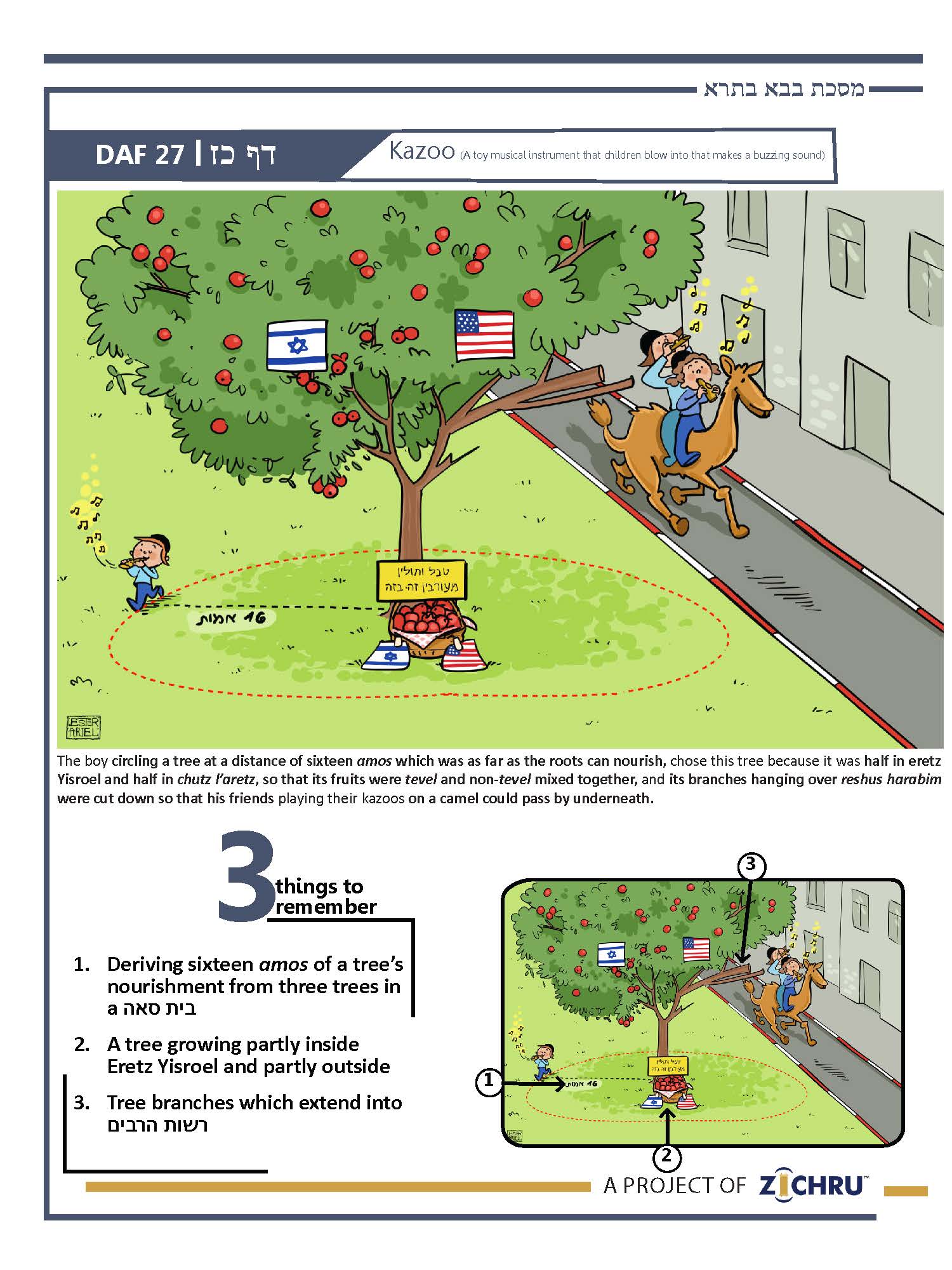Bava Basra - Daf 27
- Audio Timestamps
0:00 - The 3 Sugyos
3:02 - Review of 3 Sugyos
6:02- Siman
8:30 - 4 Blatt Back Chazarah
17:43 - Pop Quiz (Last 7 blatt)
For access to all Zichru resources including PDFs, and illustrations CLICK HERE
- Deriving sixteen amos of a tree’s nourishment from three trees in a בית סאה
The Gemara proves Ulla’s statement, that a tree derives its nourishment from roots within sixteen amos, from a Mishnah stating that if three trees, belonging to three people, are planted within a בית סאה (an area of 2,500 square amos), הרי אלו מצטרפין – they combine to be considered an orchard, and the entire בית סאה may be plowed until Shavuos before shemittah (if they were more spread out, the field may only be plowed until Pesach). Since a בית סאה totals 2,500 square amos, that amounts to 833 1/3 square amos per tree. This is less than Ulla’s measurement, which is sixteen amos in each direction, totaling 1,024 amos (32 x 32)!? The Gemara answers that Ulla’s measurement is a circle of sixteen amos in every direction. Since a square is approximately one-fourth larger than a circle inscribed in it, Ulla’s measurement is actually 768 square amos. Although this is smaller than the Mishnah’s amount of 833 1/3 amos per tree, by about ½ amah on each side, היינו דלא דק – [Ulla] was imprecise, i.e., he approximated, ולחומרא לא דק – and it is for a stringency that he was imprecise, because he only exempted from ביכורים a tree within sixteen amos from the boundary, whereas the Mishnah would exempt up to 16 ½ amos.
- A tree growing partly inside Eretz Yisroel and partly outside
Ulla is challenged from a Baraisa teaching that if a tree is partly growing in Eretz Yisroel and partly outside, Rebbe says: טבל וחולין מעורבין זה בזה – the fruit is considered tevel and [non-tevel] mixed together (because produce grown outside Eretz Yisroel is exempt from terumah, etc.). Rabban Shimon ben Gamliel says: הגדל בחיוב חייב – [the fruit] growing in the obligated [side] is obligated (in terumah), הגדל בפטור פטור – and [the fruit] growing on the exempt [side] is exempt. Their machlokes appears to be only if we can determine which parts of the tree are growing from Eretz Yisroel, but all agree that what is growing from outside Eretz Yisroel is exempt. But according to Ulla, it still draws nourishment from Eretz Yisroel and should be subject to terumah!? The Gemara answers that the case is דמפסיק צונמא – where a rock separates the roots underground, so they cannot draw nourishment from the other side.
Nonetheless, Rebbe holds: דהדרי ערבי – [the nutrients] from all the roots are remixed in the trunk, because he holds אוירא מבלבל – the airspace (i.e., the trunk) mixes the nutrients together, and Rabban Shimon ben Gamliel holds each side remains independent.
- Tree branches which extend into רשות הרבים
The Mishnah states: אילן שהוא נוטה לרה"ר – if a tree extends over a public domain, קוצץ כדי שיהא גמל עובר ורוכבו – one may cut off enough of its branches to allow a camel and its rider to pass underneath. Rebbe Yehudah says, as the Gemara will explain, that a smaller space for a camel laden with flax or twigs is sufficient, because a rider can bend over. Rebbe Shimon says the trees are cut along a plumb line, so branches will not spread tumah through אהל. The Gemara asks who the Tanna is, who holds דבנזקין בתר אומדנא דהשתא אזלינן – that regarding damages, we follow our current assessment and only cut off the branches which currently impede traffic, although they will grow back later. Reish Lakish says it is Rebbe Eliezer, who permits digging a pit in רשות הרבים, provided that its cover can withstand a wagon carrying stones, although it may later weaken and collapse. Rebbe Yochanan says that even the Tanna Kamma who argues with Rebbe Eliezer can agree here, because that Tanna is concerned with the cover’s decay going unnoticed, whereas in our Mishnah, the branches will be cut as they regrow.
Siman – Kazoo (A toy musical instrument that children blow into that makes a buzzing sound)
The boy blowing his kazoo and circling a tree at a distance of sixteen amos which was as far as the roots can nourish, chose this tree because it was half in eretz Yisroel and half in chutz l’aretz, so that its fruits were tevel and non-tevel mixed together, and because its branches hanging over reshus harabim were cut down so that his friends playing their kazoos on a camel could pass by underneath.


